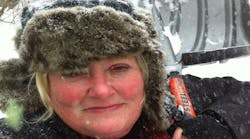When the Weather Outside Is Frightful: Safety Tips for Outside Activities in the Winter
I laughed the first time I heard that the Weather Channel had started naming winter storms. I stopped laughing when a snowmaggedon named Hercules sucker punched the Midwest and East Coast. I completely stopped laughing when the air temperature plummeted to -13F, with windchills dropping it to -35F.
Nearly two feet of snow have dropped on my hometown of Cleveland, Ohio. I worked from home yesterday and today, but a trip to a local store yesterday – a five-minute drive from my house – was a white-knuckled nightmare of a driving experience. I shoveled our walks and driveway twice yesterday, only to wake up this morning to three-foot drifts across the driveway this morning. More shoveling is in my future.
Shoveling snow is a major winter activity in many parts of the United States. Many of us consider shoveling a form of exercise, and in fact, only 15 minutes of shoveling counts as moderate physical activity. Keep this in mind, or you can increase your risk of an injury.
Take it from someone who knows; a few precautions while you are shoveling can help prevent unnecessary pain and suffering.
- If you have a history of heart problems or are inactive, talk to your doctor before shoveling. There is an increase in the number of fatal heart attacks among shovelers.
- Warm up and stretch before you get started.
- Drink plenty of water to keep yourself hydrated.
- Shovel only fresh snow. Freshly fallen, powdery snow is easier to shovel than the wet, packed-down variety.
- Push, don’t lift, the snow. It's easier on your back and uses less energy than lifting.
- Pick the right shovel for you. Don't pick up too much at once. Use a small shovel, or fill only one-fourth or one-half of a large one.
- Lift with your legs bent, not your back. Keep your back straight. By bending and "sitting" into the movement, you'll keep your spine upright and less stressed. Your shoulders, torso and thighs can do the work for you.
- Dress the part. Dress in layers; if you work up a sweat, you’ll be able to remove so me of those layers. Wear a hat and gloves to protect you extremities, wrap on a scarf and wear wool socks and waterproof boots to protect your body from the cold temperature.
- If your body is telling you to stop, listen to it. Stop if you feel pain or start seeing heart attack warning signs: chest pain; shoulder, neck or arm pain; dizziness, fainting, sweating or nausea; and/ or shortness of breath. Get medical help immediately.
Kids and Winter
When it snows, most children have fun by engaging in snowball fights, sledding, building snowmen and making snow angels. However, it is important for parents to prepare their children for the cold weather. Outside activities are wonderful as long as appropriate safety precautions are taken.
Nathan Timm, M.D., an emergency medicine physician at Cincinnati Children’s Hospital Medical Center, says it’s important for children to stay active during the winter. Timm offers these tips for parents to keep their child safe, healthy and happy while playing outside this winter:
Preparation
Children should be dressed warmly. Mittens, gloves, hats and multiple thin layers will help keep them dry and warm. Children (and adults) still can get sunburned in the winter, especially if sun is reflecting off snow. Sun screen should be applied liberally to sun-exposed skin to help prevent sunburn.
Set appropriate time limits. Depending on the temperature, parents should allow their child to play outside for 30-60 minutes, and then come back inside to get warmed up (and parents should follow that advice for themselves).
Frostbite and Frostnip
- Regularly check to make sure the child’s clothes are not wet. Children get much colder when wet. Make sure that the child is not having any signs of frostnip and or frostbite:
- Frostnip occurs when cold temperatures damage the skin and blood vessels. Frostnip usually affects the face, feet or fingertips and causes numbness and may turn skin white or blue-white.
- Frostbite literally is the freezing of the skin. The skin can feel waxy, frozen and numb, and can cause blisters.
Sledding
When sledding, younger children should be kept in separate areas from older children and the following precautions should be taken:
- A child should sit or lie down feet first rather than head first to help reduce likelihood of head injury.
- Avoid sledding hills with trees or other obstructions.
- Sled only on hills covered in snow, not ice.
- A child should wear a helmet while sledding to prevent head injuries.

